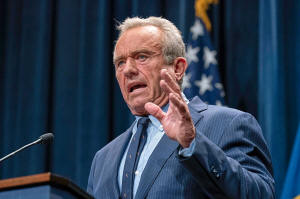US health officials seek to phase out artificial dyes from the food
supply
[April 23, 2025]
By JONEL ALECCIA and MATTHEW PERRONE
WASHINGTON (AP) — U.S. health officials on Tuesday said they would urge
food makers to phase out petroleum-based artificial colors in the
nation’s food supply, but stopped short of promising a formal ban and
offered few specifics on how they intended to achieve the sweeping
change.
Food and Drug Administration Commissioner Marty Makary said at a news
conference that the agency would take steps to eliminate the synthetic
dyes by the end of 2026, largely by relying on voluntary efforts from
the food industry. Health Secretary Robert F. Kennedy Jr., who joined
the gathering, said he had heard from food manufacturers, but had no
formal agreements with them.
“We don't have an agreement, we have an understanding,” Kennedy said.
The officials said the FDA would establish a standard and timeline for
industry to switch to natural alternatives, revoke authorization for
dyes not in production within coming weeks and take action to remove
remaining dyes on the market.
“Today, the FDA is asking food companies to substitute petrochemical
dyes with natural ingredients for American children as they already do
in Europe and Canada,” Makary said.
The proposed move is aimed at boosting children's health, he added.
“For the last 50 years we have been running one of the largest
uncontrolled scientific experiments in the world on our nation’s
children without their consent," he said.
The process to revoke approved additives from the food supply typically
takes several years and requires public comment, agency review and final
rulemaking procedures.
Industry groups said that the chemicals are safe and suggested they
would try to negotiate with regulators to keep them available.

“FDA and regulatory bodies around the world have deemed our products and
ingredients safe, and we look forward to working with the Trump
Administration and Congress on this issue,” said Christopher
Gindlesperger, spokesman for the National Confectioners Association. “We
are in firm agreement that science-based evaluation of food additives
will help eliminate consumer confusion and rebuild trust in our national
food safety system.”
Health advocates have long called for the removal of artificial dyes
from foods, citing mixed studies indicating they can cause
neurobehavioral problems, including hyperactivity and attention issues,
in some children. The FDA has maintained that the approved dyes are safe
and that “the totality of scientific evidence shows that most children
have no adverse effects when consuming foods containing color
additives.”
The FDA currently allows 36 food color additives, including eight
synthetic dyes. In January, the agency announced that the dye known as
Red 3 — used in candies, cakes and some medications — would be banned in
food by 2027 because it caused cancer in laboratory rats.

Artificial dyes are used widely in U.S. foods. In Canada and in Europe —
where synthetic colors are required to carry warning labels —
manufacturers mostly use natural substitutes. Several states, including
California and West Virginia, have passed laws restricting the use of
artificial colors in foods.
The announcement drew praise from advocates who say the dyes carry
health risks and serve no purpose beyond the cosmetic.
“Their only purpose is to make food companies money,” said Dr. Peter
Lurie, president of the Center for Science in the Public Interest and a
former FDA official. “Food dyes help make ultraprocessed foods more
attractive, especially to children, often by masking the absence of a
colorful ingredient, like fruit.”
[to top of second column]
|

Health and Human Services Secretary Robert F. Kennedy Jr. speaks
during a news conference on the Autism report by the CDC at the
Hubert Humphrey Building Auditorium in Washington, Wednesday, April
16, 2025. (AP Photo/Jose Luis Magana)
 Removing artificial dyes from foods
has long been a goal of so-called MAHA moms, key supporters of
Kennedy and his “Make America Healthy Again” initiatives. They were
among protesters who signed petitions and rallied outside the
Michigan headquarters of WK Kellogg Co. last year, demanding that
the company remove artificial dyes from its breakfast cereals in the
U.S.
Health officials insisted that food-makers wanted clarity on the
issue and were receptive to the changes, but the response from
industry groups was mixed.
Consumer Brands Association, a trade group for food manufacturers,
said it had long asked FDA to assert its authority to regulate foods
at a national level, rather than leaving it to a patchwork of state
laws. But, in a statement, the group also urged FDA officials to
“prioritize research that is objective, peer-reviewed and relevant
to human health and safety.”
It added that the ingredients in question have been rigorously
studied and demonstrated to be safe.
Hours before the announcement, the International Dairy Foods
Association said its members would voluntarily eliminate artificial
colors in milk, cheese and yogurt products sold to U.S. school meal
programs by July 2026.
Other industry groups didn't pledge any quick changes.
The International Association of Color Manufacturers said requiring
reformulation in less than two years “ignores scientific evidence
and underestimates the complexity of food production. This process
is neither simple nor immediate, and the resulting supply
disruptions will limit access to familiar, affordable grocery
items.”
Removing dyes from the food supply will not address the chief health
problems that plague Americans, said Susan Mayne, a Yale University
chronic disease expert and former director of the FDA’s food center.
“With every one of their announcements, they’re focusing in on
something that’s not going to accomplish what they say it is,” Mayne
said of Kennedy's initiatives. “Most of these food dyes have been in
our food supply for 100 years. ... So why aren’t they driving toward
reductions in things that do drive chronic disease rates?”
In the past, FDA officials said the threat of legal action from the
food industry required the government to have significant scientific
evidence before banning additives. Red 3 was banned from cosmetics
more than three decades before it was stripped from food and
medicine. It took five decades for the FDA to ban brominated
vegetable oil because of health concerns.
Some of the state laws banning synthetic dyes in school meals have
aggressive timelines. West Virginia’s ban, for example, prohibits
red, yellow, blue and green artificial dyes in school meals starting
Aug. 1. A broader ban will extend the restrictions to all foods sold
in the state on Jan. 1, 2028.
Many U.S. food companies are already reformulating their foods,
according to Sensient Colors, one of the world’s largest producers
of food dyes and flavorings. In place of synthetic dyes, food makers
can use natural hues made from beets, algae and crushed insects and
pigments from purple sweet potatoes, radishes and red cabbage.
___
Aleccia reported from California.
All contents © copyright 2025 Associated Press. All rights reserved |